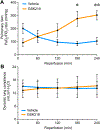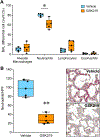Transient receptor potential vanilloid 4 channel inhibition attenuates lung ischemia-reperfusion injury in a porcine lung transplant model
- PMID: 38678474
- PMCID: PMC11416340
- DOI: 10.1016/j.jtcvs.2024.03.001
Transient receptor potential vanilloid 4 channel inhibition attenuates lung ischemia-reperfusion injury in a porcine lung transplant model
Abstract
Objective: Transient receptor potential vanilloid 4 (TRPV4) is a nonselective cation channel important in many physiological and pathophysiological processes, including pulmonary disease. Using a murine model, we previously demonstrated that TRPV4 mediates lung ischemia-reperfusion injury, the major cause of primary graft dysfunction after transplant. The current study tests the hypothesis that treatment with a TRPV4 inhibitor will attenuate lung ischemia-reperfusion injury in a clinically relevant porcine lung transplant model.
Methods: A porcine left-lung transplant model was used. Animals were randomized to 2 treatment groups (n = 5/group): vehicle or GSK2193874 (selective TRPV4 inhibitor). Donor lungs underwent 30 minutes of warm ischemia and 24 hours of cold preservation before left lung allotransplantation and 4 hours of reperfusion. Vehicle or GSK2193874 (1 mg/kg) was administered to the recipient as a systemic infusion after recipient lung explant. Lung function, injury, and inflammatory biomarkers were compared.
Results: After transplant, left lung oxygenation was significantly improved in the TRPV4 inhibitor group after 3 and 4 hours of reperfusion. Lung histology scores and edema were significantly improved, and neutrophil infiltration was significantly reduced in the TRPV4 inhibitor group. TRPV4 inhibitor-treated recipients had significantly reduced expression of interleukin-8, high mobility group box 1, P-selectin, and tight junction proteins (occludin, claudin-5, and zonula occludens-1) in bronchoalveolar lavage fluid as well as reduced angiopoietin-2 in plasma, all indicative of preservation of endothelial barrier function.
Conclusions: Treatment of lung transplant recipients with TRPV4 inhibitor significantly improves lung function and attenuates ischemia-reperfusion injury. Thus, selective TRPV4 inhibition may be a promising therapeutic strategy to prevent primary graft dysfunction after transplant.
Keywords: TRPV4 channel; endothelial barrier; inflammation; ischemia-reperfusion injury; lung transplantation; primary graft dysfunction.
Copyright © 2024 The American Association for Thoracic Surgery. Published by Elsevier Inc. All rights reserved.
Conflict of interest statement
Conflict of Interest Statement The authors reported no conflicts of interest. The Journal policy requires editors and reviewers to disclose conflicts of interest and to decline handling or reviewing manuscripts for which they may have a conflict of interest. The editors and reviewers of this article have no conflicts of interest.
Figures








References
-
- Gelman AE, Fisher AJ, Huang HJ, Baz MA, Shaver CM, Egan TM, Mulligan MS. Report of the ISHLT working group on primary lung graft dysfunction Part III: Mechanisms: A 2016 consensus group statement of the International Society for Heart and Lung Transplantation. J Heart Lung Transplant 2017;36(10):1114–1120. doi: 10.1016/j.healun.2017.07.014 - DOI - PMC - PubMed
MeSH terms
Substances
Grants and funding
LinkOut - more resources
Full Text Sources
Medical

